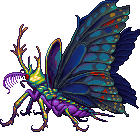Viewing 7iwvI

Father: Unknown
Unknown Pedigree
Hardiness: 49
Appearance: 1
Emerged: 4:31 30.04.2024
Matured: 19:33 01.05.2024
Although only found in dark caves, Cielarka Cimos display a surprising array of colors. This diversity of patterns and shades may be caused by their main source of food: a bioluminescent moss called Kaverno Musko. Their eyes are particularly sensitive to the soft light given off by the moss, and they can detect slight differences in wing patterns even in such a dim setting. Cielarka Cimo males will display their wings to potential mates in demonstrations of their aerial agility. Flight capability is particularly important for evading their two main predators—Ombra Vespertos and Senvida Nagantos—and thus the main attribute for choosing a mate. Eggs are laid in clumps on blades of Stona Strio, an aquatic grass, just below the water level. Grubs are semiaquatic until they leave the water to pupate, after which they emerge fully formed as adults. When at rest—they do not sleep, but relax in a state of torpor for several hours at a time—their folded wings are partially covered by a hard outer shell, which serves as protection and camouflage. In a laboratory setting, they show no fear of bright lights and will often flock around them. For this reason, they should be kept away from open flames, as their delicate scaled wings are easily damaged.
The creatures that dwell in this rather desolate world still display some diversity in appearance, eating habits, and social behavior. Whether they have fur or feathers, skin or scales, their unique genetic makeup allows for a variety of colors and markings within each species. Despite limitations in food sources, herbivores, omnivores, and carnivores are all present in the food chain, and each species requires specialized care within a laboratory. Although the artificial setting of housing units and breeding pods precludes most opportunities to study true interspecific behavior, the interactions within and between species has been studied extensively in the wilderness by scientists daring enough to venture beyond the outpost’s walls.
